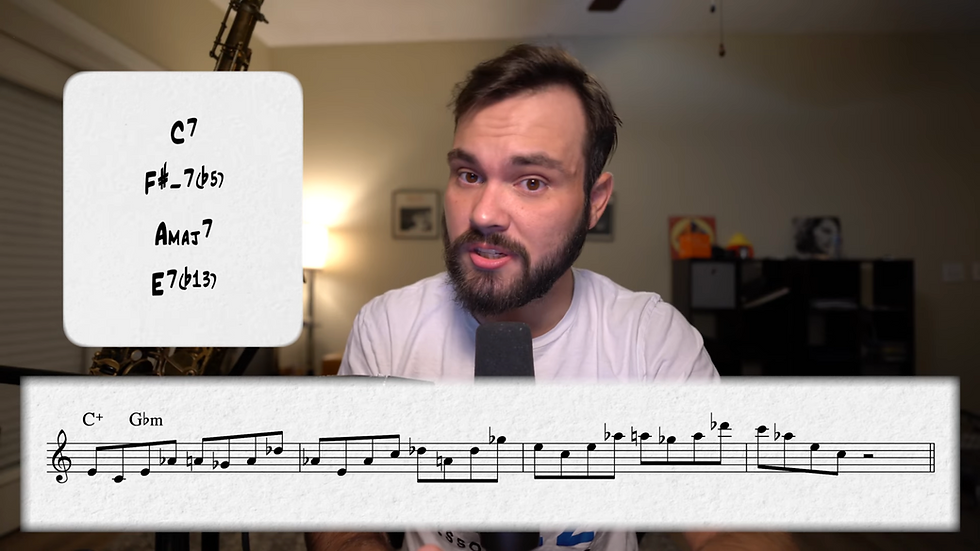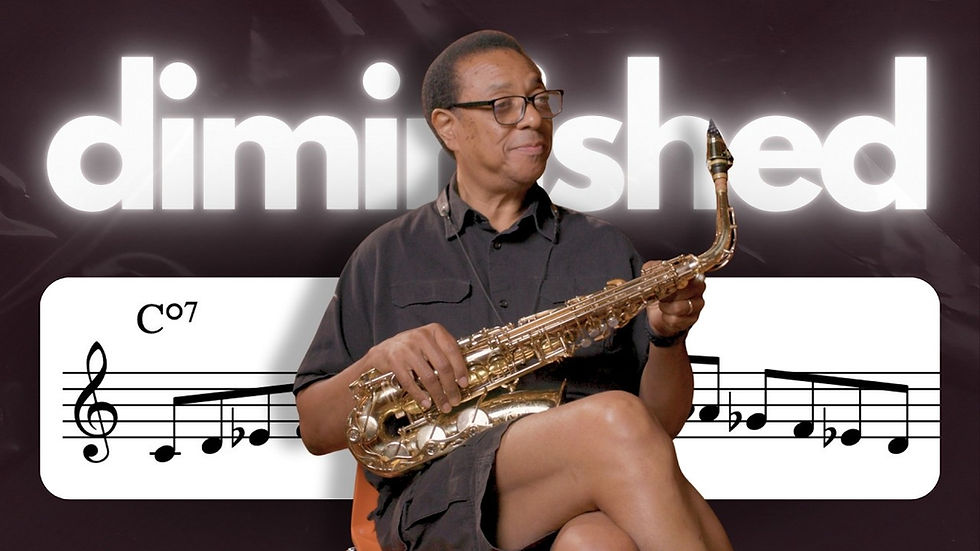The Concept You Didn’t Know You Need feat. Ryan Devlin
- Jazz Lesson Videos

- Nov 6
- 5 min read
Are you looking for a way to spice up your lines with something a little different? Today we’re going to break down some of Ryan’s favorite ways to practice and apply the augmented sound. These ideas are for anyone who's listened to a solo and thought, “what is that bright inside (yet outside), modern-sounding scale or line, and how can I get that into my playing?”
The augmented scale has been a part of jazz for decades, from players like Coltrane to Woody Shaw all the way to more modern voices like Seamus Blake and Donny McCaslin, whom Ryan studied with at New England Conservatory.
The augmented scale can be defined in many ways, but the most straightforward way is thinking about it the same way we do with triads. When you take a major triad and raise your fifth a degree, it becomes augmented. The same technique can be applied to scales.
For example, take a minor pentatonic, 1, b3, 4, 5, b7 and then raise the fifth. Or take the major scale and raise the fifth (that’s the major bebop scale, which we’ll discuss later). But augmented is generally referring to anything with a raised 5.

By studying the relationship between augmented scales, sharp five chords, and triad pairs, you can start to hear how this sound can create those bright inside/outside ideas that add color and forward momentum to your lines, and with these concepts we're going to talk about today, it'll be easy to integrate them into your solo.
All the material that we're going over today comes from Ryan’s newest resource with Jazz Lesson Videos called 125 Augmented Phrases. This PDF dives deep into how the augmented sound functions across different harmonic situations—from scale-based vocabulary to applied lines and triad pair motion. In it, we cover augmented scale patterns, dominant 7#5 phrases in and outside of ii-V-I progressions, augmented pentatonics and augmented triad pair concepts.
And, if you want to hear how Ryan plays through any of the things we talk about today, make sure to check out our accompanying YouTube video “The Concept You Didn’t Know You Need feat. Ryan Devlin.”
Now let’s get playing!
Contents
Augmented scale patterns
The first concept we're going to check out is augmented scale patterns. But first of all, what is the augmented scale? The augmented scale is basically an augmented triad where every chord tone of your augmented triad is approached by half step. So if we think about the C augmented scale, it goes C, Eb, E, G, G#, and then B natural to C again. So this is a hexatonic or six-note scale.

Let’s look at the first pattern from our book, a descending pattern with our augmented scale.

Just like any new scale that we introduce, a great way to practice this is in its pattern and in different keys.

What's cool about a symmetrical scale is that any note in the augmented triad could be the root. So for example, the C augmented scale, the E augmented scale, and the A flat or G sharp augmented scale are exactly the same—you only have to learn four different scales, because this covers all 12 notes. Which means this pattern allows you to play in four different keys.

The C augmented scale works over C major, Ab major, and E major, the three chord tones of our triad—also over B7b9 and FmM7. Try playing this line against these chord changes.
A direct way to apply this into your improvisation is to pick a tune that's in one of those key centers and immediately apply this.
Here's Ryan using it while improvising over Oleo.

What's cool about this augmented scale is that we can apply different techniques alongside it, like chromatic approaches and minor pentatonics. In the resource, we also have multiple examples of the augmented scale being used in and out of those contexts. This really starts to help us gain a true feeling of improvisation with this concept, when you can combine them with other traditional concepts in jazz.
ii7 - V7#5 - Imaj7 progressions
Now let's move on to our second concept, which is going to be on ii7 - V7#5 - Imaj7 progressions. We're taking a traditional ii-V-I, phrase, and on the V chord, we're going to be playing the dominant #5 bebop scale. That is your regular bebop scale, or mixolydian with a passing tone. It's spelled C, D, E, F, G, A, Bb, B, C.

That's the traditional version. We're going to put the passing tone between the fifth and the sixth, instead of between the seventh and the root.

Our new scale, or the dominant 7#5 bebop scale, is going to be C, D, E, F, G, G#, A, Bb, C. And in our resource, we have different examples of lines that are just with that scale—with and without the ii-V-I progression.
Taking a look at this section on our ii chord. We stay diatonic and play on Gm7. We’re playing Gm7 tonality, sometimes in arpeggios, sometimes in scales. Then when we get to our C7#5 chord, we’re really emphasizing the #5 tonality and resolving to Fmaj7.

As you can see, we’re playing diatonically on our ii chord. We’re starting on D and going up a minor pentatonic phrase from D over Gm, playing the Gm pentatonic scale starting on the 5, then we play a really common #5 phrase on the #5 chord—C, G#, G, F, targeting the third, and then C, G#, E, F, resolving to the root of that chord.

Another great way to apply this improv is to find a tune that has a ii-V-I in this key center and apply the lick. Try using the lick over the tune “It Could Happen to You.” This tune is in the key center of F, and there's a couple ii-V-Is that go Gm, C7, F, which works great with our lick.
Augmented triad pairs
Moving on to our next concept, we’ll look at some augmented triad pairs from our resource. So in our resource, we have a couple different versions of augmented triad pairs, some with minor chords, some with other augmented chords. So let's take a look at two different ones.
We're gonna look at two augmented triads a whole step apart. This is the same thing as the whole tone scale.

This pattern works over C7, F#7, B7#5, and D7alt. Let's take a look at this pattern with all those chord changes being played underneath.
Let's take a look at another triad pair. This is an augmented triad pair with a minor triad a tritone apart. So now we're taking C+ and F#m triad.

This cool combination of bright and dark works over C7, F#m7b5, Amaj7, and E7b13.
These triad pairs are a great way of creating angular, intervallic motion through the harmony that has that augmented sound in it. This approach gives you lines built on tension and release. The cool thing about triad pairs is they usually have inside notes to a chord and outside notes as well—it's not like it just fits one tonality. You have this snaking through the harmony, especially with these designed patterns. It's one of the most expressive ways to stretch the augmented sound in your solo and a lot of great players do this.
That’s all we have for today, but if you want to look at more concepts like this, make sure to check out Ryan’s resource with Jazz Lesson Videos, 125 Augmented Phrases, as well as our accompanying YouTube video “The Concept You Didn’t Know You Need feat. Ryan Devlin.”
We’ll see you next time!



Comments